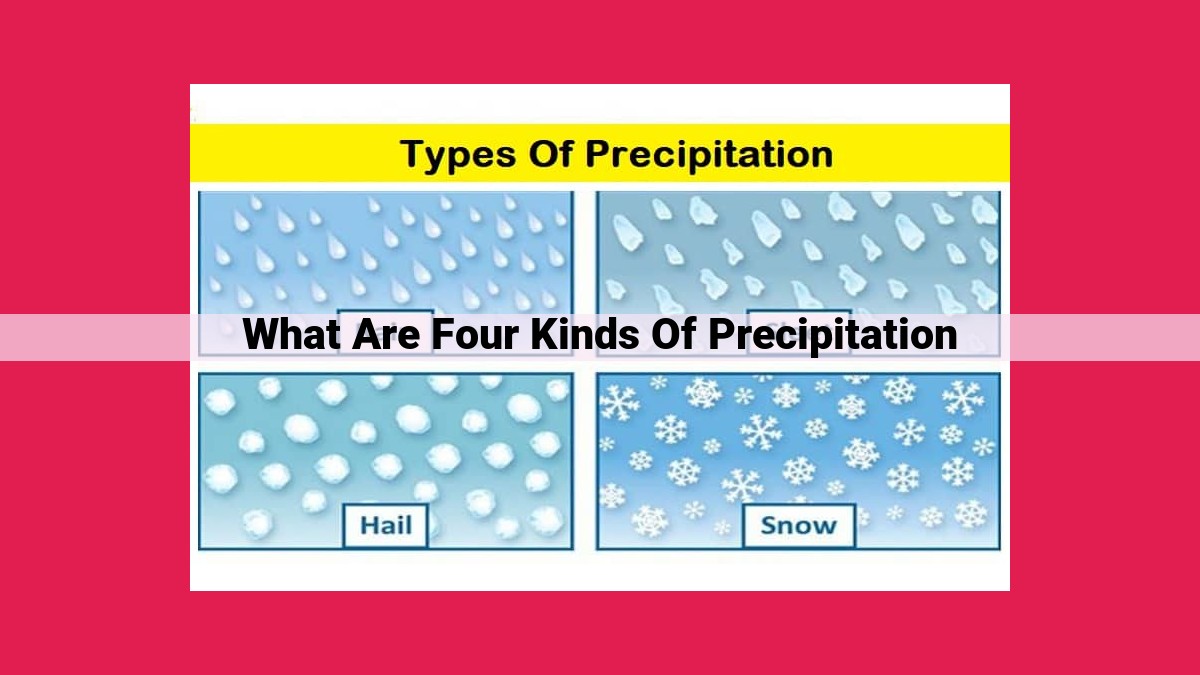Types Of Precipitation: Rain, Snow, Hail And Sleet Explained

Precipitation refers to water released from the atmosphere in various forms. It can manifest as rain, liquid droplets falling from clouds; snow, frozen water crystals forming snowflakes; hail, larger hailstones formed within thunderstorms; and sleet, a combination of rain and ice particles.
Rain: Understanding Liquid Precipitation
Rain, the quintessential form of liquid precipitation, is a mesmerizing spectacle that nourishes our planet. Its glistening droplets, descending from the heavens, have captivated us for millennia, etching their presence in our art, literature, and everyday experiences.
Definition and Characteristics
Rain refers to the visible droplets of water that fall from clouds, with a diameter of 0.5 millimeters or larger. These droplets form when tiny water particles in the atmosphere collide, coalescing into larger bodies.
Formation Process
Rain’s genesis begins with water vapor in the air. As this vapor cools, it condenses into minuscule droplets or ice crystals. Upward currents within clouds uplift these droplets, where they encounter cooler air. This initiates the coalescence process, where droplets merge into larger, heavier ones. Once these droplets become too heavy to remain suspended, they descend as rain.
Atmospheric Conditions
The formation of rain is contingent upon atmospheric conditions:
- Sufficient moisture: The air must contain an ample amount of water vapor.
- Cooling mechanisms: The air must be cooled to its dew point, the temperature at which water vapor condenses.
- Upward air currents: Convection or other mechanisms must provide the lift necessary for droplets to grow and coalesce.
Related Concepts
Rain is one of several forms of precipitation, alongside snow, hail, and sleet. It is integral to the hydrological cycle, replenishing Earth’s freshwater supply and supporting countless ecosystems. Rain also plays a vital role in regulating weather patterns, influencing temperature and humidity levels.
Snow: Frozen Precipitation from Water Vapor
Snow, a crystalline delight, is a captivating form of precipitation that transforms water vapor into intricate and ephemeral art. Its formation is a fascinating dance between temperature, humidity, and atmospheric conditions.
Formation and Characteristics of Snowflakes
Snowflakes are born within clouds when tiny ice crystals collide and merge. Each crystal resembles a hexagonal prism, with delicate branches adorned like intricate lace. These branches form when water molecules attach to the crystal’s surface, creating a kaleidoscope of shapes and sizes.
Atmospheric Conditions Necessary for Snow
Snowfall requires frigid temperatures, typically below freezing. The air must also be saturated with water vapor, which condenses into liquid water droplets. These droplets freeze into ice crystals only when the temperature drops below 32°F (0°C).
Related Concepts: Precipitation, Clouds, Temperature, Winter
Snow is a type of precipitation that falls in solid form. It forms within clouds, primarily cirrus clouds, which are composed of ice crystals. Snow is closely tied to the season of winter, when temperatures are consistently below freezing.
In conclusion, snow is a beautiful and captivating meteorological phenomenon. Its formation is a delicate interplay of atmospheric conditions, creating a mesmerizing winter tapestry that transforms the landscape into a breathtaking wonderland.
Hail: The Aftermath of Thunderstorms
In the heart of a powerful thunderstorm, a fascinating atmospheric phenomenon takes place, giving birth to frozen wonders known as hail. These icy projectiles are the result of a complex interplay between updrafts, downdrafts, and temperature variations within the towering storm clouds.
As updrafts carry moisture-laden air high into the atmosphere, it cools and condenses, forming ice crystals. These crystals then collide with supercooled water droplets, which freeze onto their surfaces, creating small, icy pellets.
As these pellets are repeatedly lifted and dropped within the storm, they grow in size, accumulating layers of ice. The shape and size of hailstones vary depending on the strength of the updrafts and downdrafts, as well as the temperature and humidity conditions within the cloud. Some hailstones can grow to be as large as golf balls or even tennis balls, posing a significant threat to property and life.
Hail is a hallmark of severe thunderstorms and can accompany other hazardous weather conditions such as lightning, strong winds, and heavy rainfall. Understanding the formation process of hail helps us better forecast and prepare for these potentially destructive weather events.
Sleet: When Rain Takes a Frigid Twist
Imagine a world where raindrops freeze mid-air, transforming into tiny icy pellets that pitter-patter against your windowpane. That’s the beauty of sleet, a curious meteorological phenomenon that bridges the gap between rain and snow.
The Chilling Dance of Freezing Rain
Sleet’s remarkable birth begins as raindrops fall from clouds high in the atmosphere. As they descend, they encounter a layer of air near the ground that’s below freezing. Instead of melting into puddles, the raindrops become supercooled, remaining liquid even though their temperatures have dipped below 0°C.
But the icy dance doesn’t end there. Upon contact with surfaces such as trees or buildings, the supercooled raindrops instantly freeze, forming the signature sleet pellets. These pellets bounce and skid along the ground, creating a unique symphony of icy clicks.
Sleet’s Icy Characteristics
Sleet pellets are typically small and spherical, ranging in size from 1 to 5 millimeters. They are translucent, with a white or frosted appearance. Unlike snowflakes, sleet pellets are solid and do not have intricate crystalline structures.
Winter’s Playful Precipitation
Sleet is a common sight during late autumn and early spring when temperatures fluctuate around the freezing point. It is often accompanied by cold fronts and wintery showers, making it a playful ally of the winter season.
Sleet can impact transportation and safety, as it can make roads icy and treacherous. However, it also brings a touch of magic to the winter landscape, transforming the world into a realm of frozen droplets and playful ice crystals. Embrace the whimsical charm of sleet next time you encounter its icy wonders.